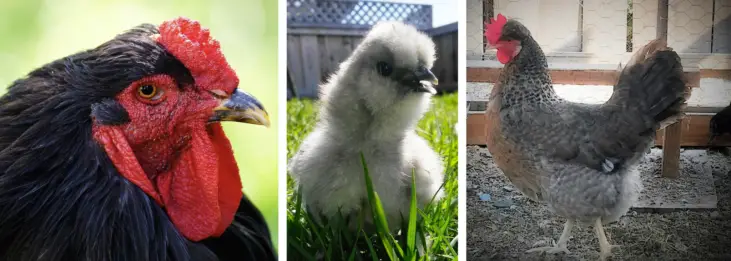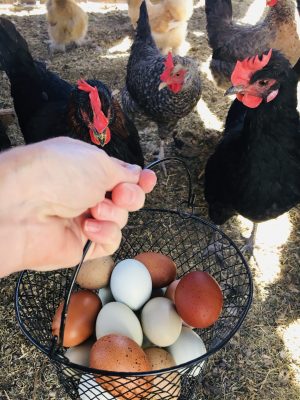
With over 26 billion chickens in the world today, they outnumber humans by over 3 times! Chickens are the most common farm animal in the world today. Unfortunately, most people do not realize what fascinating creatures they actually are. Here are the top 11 amazing facts about chickens you must know.
#1 Chickens are Descendants of Dinosaurs

Yes, you heard that right. Chickens have been found to be related to the Tyrannosaurus Rex dinosaur! Scientists sequenced the collagen protein of a Tyrannosaurus Rex bone that was found in Colorado and found that chickens have very similar gene sequences. This tells us that chickens most likely evolved from dinosaurs!
| SIMILARITIES BETWEEN CHICKENS AND DINOSAURS |
|---|
| FUSED CLAVICLES |
| HOLLOW BONES |
| AIR POCKETS IN BONES |
| SIMILAR HIP STRUCTURE |
| SIMILAR EGGSHELL MICROSTRUCTURE |
| “S” SHAPED NECK |
| HINGE LIKE ANKLE JOINTS |
| BODY IS SUPPORTED BY 3 TOES |
| ERRECT POSTURE |
| LARGE ORBITS FOR EYES |
| POSSIBLY FEATHERS |
#2 Mother Hens Talk to Their Chicks Before They Hatch

It’s true! Around day 20 of incubation, a chick will break through the inner membrane within the egg. This allows the chick to take its first breath of air. If you listen carefully, you can hear little “chirps” inside the egg.
During this time, mama hen is aware that her chicks are getting close to hatching and will communicate to her chicks by making quiet little “bock-bock” noises and purring. This encourages them to keep working on the difficult task of hatching. Her baby chicks can hear and they will talk back too!
#3 Chickens Can Not Taste Sweet

The way a chicken tastes food is quite different than how a human tastes it. This is likely because an adult chicken has far fewer taste buds than we do, lacking sweet taste buds totally. Depending upon the breed, an adult chicken has between 250-350 taste buds. Humans have around 10,000 taste buds.
Unlike humans that have 5, chickens have only four different types if taste receptors. These are sour, bitter, salt and umami.
Umami, or savoriness, is one of the five basic tastes. It has been described as savory and is characteristic of broths and cooked meats. People taste umami through taste receptors that typically respond to glutamates and nucleotides, which are widely present in meat broths and fermented products.
Wikipedia
#4 Farm Fresh Chicken Eggs are Protected from Bacteria

When a hen lays an egg, right before it is laid, a protective coating called a “bloom” or “cuticle” is coated over it. This protects farm fresh eggs from harmful bacteria penetrating through the many pores of the egg shell. Without this protective coating, eggs would be susceptible to becoming contaminated.
Supermarket eggs do not have this protective coating on them. Laws require supermarket eggs to be washed, sanitized and refrigerated. When eggs are washed, it removes the protective coating or bloom.
Once eggs have been refrigerated, they need to remain in the refrigerator until ready to use. Removing cold eggs from the refrigerator into a cold or even room temperature environment will cause the eggs to sweat. Whether or not the eggs have their protective bloom, it still predisposes them to becoming contaminated.
Moisture on an egg will remove some of the protective coating. Bacteria can attach to the moisture droplets and penetrate through the pores and into the egg. This is why, according to the FDA, all refrigerated eggs should be consumed within 2 hours of taking them out.
#5 Chickens Take Baths in the Dirt

Yep, chickens take their baths in the dirt! It’s called a “dust bath,” and chicken love doing it! I guess you can say that chickens are not like us when it comes to getting clean.
Chickens are susceptible to fleas, mites, lice and other parasites and dust baths are a chickens way of killing off all of these nuisance bugs.
Have you ever seen a chicken taking a dust bath? It is actually pretty entertaining to watch. The first time you see it, it may alarm you to see a chicken wiggling on the ground, flinging dirt all over themselves. When they are finished getting dirt all over their feathers and down to their skin, they will get up and shake all the remaining dust, dirt or sand off.
Chickens like to find a soft area of dirt or sand and dig a little hole that they can lay down in a wiggle around, flinging dirt up into their ruffled up feathers. This is their equivalency to a shower. By doing this, it is clogging the breathing pores of parasites that may have attached themselves to the chicken.
Chickens take dust baths instinctively to clean themselves. Even very young baby chicks can be seen doing this in their pine shavings of their brooder!
#6 A Mother Hen Instinctively Knows How Often to Turn Her Eggs
A developing chick embryo needs to be turned several times a day, especially during the first 10 days of development. A mother hen instinctively knows how often to turn her eggs and will turn them at least 50 times a day.
During the first week of embryonic development, this is when the extra-embryonic yolk sac membrane and the sub-embryonic fluid are being formed. Not turning the egg frequently enough will cause the embryo to stick to the shell membrane, causing increased mortality.
#7 Hens Don’t Need a Rooster to Lay an Egg
A hen will begin laying eggs around 20-24 weeks of age regardless of whether a rooster is around. Depending upon the breed, she may lay 300+ eggs a year. If the eggs are not fertilized by a rooster they will not be fertile. So they will not be capable of producing more chicks. Both fertile and non-fertile chicken eggs are safe to eat and taste the same.
#8 Hens Poop, Mate and Lay Eggs Using the Same Orifice
Hens poop, mate and lay eggs through a cloaca. This is the only opening for a hens feces to be expelled, for reproduction and for eggs to be laid through.
When a hen lays an egg, it will pass through her cloaca or “vent.” This is the same area she excretes feces. But when she lays an egg, she will invert her oviduct, blocking any feces from contaminating the egg. Pretty amazing!
Fun Facts About Chickens: Both Roosters and Hens Have a Cloaca
Both roosters and hens have a cloaca. During mating, a rooster will touch his cloaca to a hens cloaca to transfer sperm. This is called a “cloacal kiss.”
#9 Chickens Have Their Own Language

Chickens are very social animals, having their own language with over 30 different calls that humans can distinguish. I’m sure there are quite a few more calls that we will hopefully learn more about.
Chicks begin to learn how to communicate even before they come out of the egg. Mama hen and baby chick communicate with each other when the chick embryo breaks through the first egg membrane and takes its first breath, around day 20 of incubation.
Chickens use a certain call to warn other flock members of a predator from up above and a different call if a predator is coming from down on the ground. Pretty amazing!
The most popular vocalization is the well known “egg song” that a hen will sing to let everyone know that she just laid the most beautiful egg!
Chickens will call out to other flock members to let them know they are scared, upset, hungry or have found a really good bug to eat.
#10 Chickens Don’t Chew Food
Chickens don’t chew food because they don’t have any teeth. Instead, they peck food with their beak, passes through the esophagus and it is stored in their crop, an area just at the base of the neck for up to 12 hours.
Little by little, food from the crop will pass into the “gizzard” of a chickens’ stomach. The gizzard is a muscular part of the stomach that uses both the digestive juices and grit (tiny, hard particles of sand and pebbles) to break it down into smaller particles that can more easily be digested.
Fun Facts About Chickens: Do Chickens Have 2 Stomachs?
No, chickens only have 1 stomach. Unlike humans though, chickens have 2 parts to their stomach. The first part of their stomach is the gizzard or the muscular part of the stomach. (Humans don’t have this.). This is where food is broke down into more digestible pieces. From here is moves into the glandular part of the stomach where the food is mixed with digestive juices.
#11 Chickens See Better Than Humans

Chickens are some pretty amazing little creatures when it comes to their eyes! There are so many interesting facts about chickens and their eyes.
| 10 AMAZING FACTS ABOUT CHICKENS EYES |
|---|
| 1. CHICKENS HAVE 3 EYELIDS |
| 2. CHICKENS BLINK DIFFERENTLY |
| 3. THEY USE THEIR EYES INDEPENDENTLY |
| 4. CHICKENS SEE MORE COLORS THAN HUMANS |
| 5. CAN’T SEE IN THE DARK |
| 6. CHICKS PREFER RED AND ORANGE |
| 7. BABY CHICKS SEE BETTER THAN HUMAN BABIES |
| 8. CAN OLY MOVE EYEBALLS VERY LITTLE |
| 9. CAN RECOGNIZE UP TO 100 FACES |
| 10. CHICKENS CAN REMEMBER FACES |
For more details about the fascinating facts about chickens eyes, read my article, 10 Amazing Facts You Should Know About Chickens Eyes.
Conclusion: 11 Amazing Facts About Chickens You Should Know
Something that I have learned over the many years of owning chickens, is that it is a continuous learning process. The longer you have them, the more you learn. Chickens are both amazing and fascinating creatures! Hopefully you learned something new about them.








